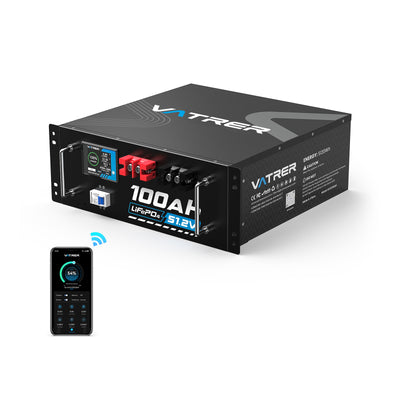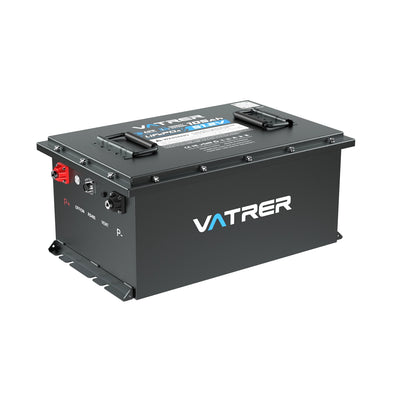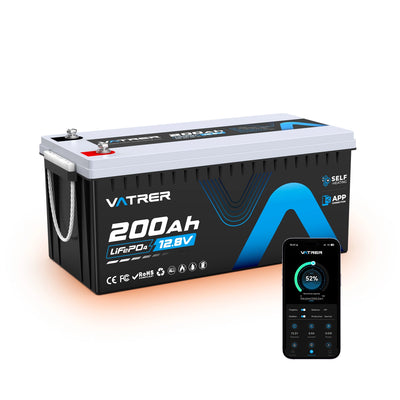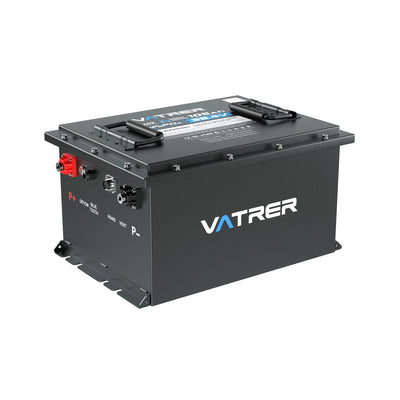
How To Charge a Deep Cycle Battery With Solar Panel
Utilising solar power to run your campervan, sailing boat, or an off-grid cottage is an efficient way to remain self-sufficient while reducing your environmental footprint. A deep-cycle solar battery—engineered for consistent and prolonged energy supply—works seamlessly with solar panels to store electricity for your journeys.
In this guide, you’ll discover the essential steps for installing a dependable solar battery charger for a deep-cycle battery. Let’s look at how to make the most of solar energy efficiently and safely.

Understanding Deep-Cycle Batteries for Solar Systems
Selecting an appropriate battery is the foundation for any efficient solar-charging setup. Unlike automotive batteries that release quick energy bursts, deep-cycle batteries are made to handle frequent charge and discharge cycles, making them perfectly suited to solar installations. Below is an overview of the main categories:
| Battery Type | Cost | Lifespan | Maintenance | Environmental Impact | Best For |
|---|---|---|---|---|---|
| Lead-Acid (Flooded, AGM, Gel) | ≈$260/kWh, cost-effective | 3–5 years (300–5,000 cycles) | Periodic checks (top up water, clean terminals) | Contains lead—hazardous, requires controlled recycling | Fixed setups such as residential solar storage |
| Lithium-Ion (LiFePO4) | ≈$271/kWh, higher initial investment | 8–10 years (up to 4,000 cycles at 80% DOD) | Very low, built-in Battery Management System (BMS) enhances safety | Less toxic, recyclable through specialist schemes | Both mobile and stationary use (caravans, boats, off-grid homes) |
- Lead-Acid Batteries: These are affordable and robust, though comparatively heavy (typically 27–45 kg for a 100Ah model). They need periodic maintenance such as refilling electrolyte or checking corrosion. Ideal for stationary installations where weight is not an issue; however, disposal requires care due to lead content.
- Lithium-Ion Batteries: Vatrer 12V deep-cycle solar batteries, especially the LiFePO4 range, weigh roughly one-third of a lead-acid equivalent (around 11 kg for 100Ah) and deliver charge efficiencies up to 95%. The integrated BMS protects from over-voltage, overheating, and cell imbalance, supporting a longer lifespan. Lithium batteries are recyclable through certified programmes and are far less harmful to the environment.
For solar energy systems, lithium-ion—particularly LiFePO4—batteries represent the best deep-cycle battery option due to their longevity, minimal upkeep, and lightweight nature, making them ideal for motorhomes and marine applications. A 12V 200Ah deep-cycle battery such as Vatrer’s can hold around 2.4kWh of energy—enough to operate appliances like fridges, pumps, or LED lighting.

How Solar Panels Recharge a Deep-Cycle Battery
Charging a deep-cycle battery through solar energy converts sunlight into electricity and stores it efficiently for later use. The process works as follows:
- Solar Panels: Photovoltaic (PV) modules produce direct-current (DC) power. Monocrystalline panels—reaching up to 22% efficiency—offer excellent performance for compact solar systems.
- Charge Controller: Manages voltage and current, protecting batteries from overcharging or excessive discharge.
- Solar Battery: Retains stored power for night-time or cloudy periods.
- Inverter (Optional): Converts DC into alternating current (AC) for running household or standard electrical devices.
A 12V 100Ah battery has a total capacity of 1.2kWh (100Ah × 12V). A 150–200W solar panel can recharge it within approximately 5–8 hours of strong sunlight. Partial shading, however, may reduce performance by half or more. Modern modules usually include bypass diodes to reduce shading losses—therefore, position your panels clear of obstructions such as foliage or roof edges.
If you are planning a home solar upgrade, explore this guide for budgeting insights: How much is a solar system for a 2000 sq ft house?

Why a Charge Controller Is Essential for Deep-Cycle Solar Systems
A charge controller is indispensable when recharging deep-cycle batteries with solar power, particularly for panels rated above 5W. It safeguards the battery by balancing current and voltage, preventing damage from overcharging or excessive discharge—both of which can shorten the service life. Below are the main controller types:
| Controller Type | Efficiency | Cost | Best For |
|---|---|---|---|
| MPPT (Maximum Power Point Tracking) | 93–97%, optimises power capture | Higher | Larger installations, lithium batteries |
| PWM (Pulse Width Modulation) | Up to 60% loss of potential output | Lower cost | Smaller setups, lead-acid batteries |
| On/Off | ≈85%, limited features | Least expensive | Low-demand uses |
- MPPT Controllers: Around 30% more efficient than PWM types—excellent for lithium units requiring precise voltage regulation. They adapt dynamically to light variation to achieve optimal charging.
- PWM Controllers: Economical but less efficient, fitting for compact or lead-acid systems.
- On/Off Controllers: Basic functionality and rarely employed, unsuitable for lithium technologies.
For any deep-cycle solar battery, an MPPT regulator ensures safe, accurate, and efficient charging—especially with lithium-ion batteries such as Vatrer’s, which rely on controlled voltage profiles.
Choosing the Ideal Solar Panel for Charging a Deep-Cycle Battery
The best solar panel for your deep-cycle battery depends on its capacity, exposure to sunlight, and available installation space. The primary panel types include:
- Monocrystalline Panels: High efficiency (15–22%), compact and long-lasting—excellent for motorhomes or yachts with restricted surface area.
- Polycrystalline Panels: Slightly less efficient (13–16%) yet more affordable, suitable for wider roof-mount arrays.
- Thin-Film Panels: Lightweight and flexible—great for portable or temporary uses like camping—but generally less efficient (10–12%) and space-demanding.
Key Factors to Consider
- Wattage: A 12V 100Ah battery needs roughly 150–200W to charge fully in 5–8 sunlight hours. A 12V 200Ah solar power deep-cycle battery will require about 300–400W for quicker recharging.
- Sunlight Conditions: In bright climates, 150–200W is often sufficient for small systems, while cloudier regions may need panels of 300W or more. Since panels lose 1–2% efficiency annually, oversize them by 10–15% (e.g., 220W for a 200W need) to sustain performance over time.
- Panel Orientation: Aim panels towards peak sunlight (typically between 10:00 and 14:00). Adjust the angle to your latitude ±15° (for example, tilt 30° at 45° latitude during winter) and prevent shading from trees or buildings.
Vatrer 12V deep-cycle solar batteries combine effectively with a 200W monocrystalline panel, ensuring consistent charging and energy reliability when living off-grid.
Setting Up a Solar Charger for a Deep-Cycle Battery
Installing a solar charger for deep-cycle batteries is simple when following the correct procedure:
- Select Your Components: Choose an appropriate solar module (150–400W for a 100Ah unit), an MPPT controller, and a solar lithium-ion battery. For higher-capacity systems, connect panels in series (to increase voltage) or in parallel (to expand capacity). Vatrer 12V deep-cycle batteries support 4P4S arrays. For extensive solar projects, consider 48V batteries such as 51.2V 100Ah rack-mounted or 200Ah wall-mounted versions. Custom expansion can also be arranged as required.
- Mount the Controller: Fix it in a dry, well-ventilated area. Connect the solar leads to the controller input via MC4 connectors.
- Attach the Battery: Link the controller output to the battery terminals (red = positive, black = negative) using ring terminals or Anderson plugs for secure high-current transfer.
- Position Panels: Place in direct sunlight, angled to your latitude ±15°. Keep the surface free of dust or debris.
- Monitor Operation: Use the controller display or mobile app to check voltage readings (14.4V–14.6V for 12V LiFePO4). Vatrer’s BMS prevents overvoltage and temperature-related faults, ensuring safe charging.
- Safety Check: Confirm all terminals are tight, double-check polarity to avoid short circuits, and ensure the system is earthed for protection.
Note: Charging lithium batteries directly from panels without a controller may seriously shorten their lifespan.
Best Practices for Solar Charging of Deep-Cycle Batteries
To get the highest efficiency from your deep-cycle solar battery, consider these recommendations:
- Panel Care: Clean every 1–2 months—dust can reduce output by up to 20%. Adjust tilt angle seasonally (latitude + 15° in winter, latitude – 15° in summer) to capture optimal sunlight.
- Battery Health: Use the controller screen or monitor to observe charge status. All Vatrer solar batteries feature integrated BMS with Bluetooth access, allowing you to check balance and prevent overcharge or low-voltage conditions.
- Temperature Control: Keep batteries between 0°C and 25°C. Extreme heat (above 35°C) lowers capacity; cold (below 5°C) slows charging. Use insulated housings if required.
- Weather Preparedness: Cloudy conditions can drop panel output by up to 90%. Oversize your array by about 20% (e.g., 240W for a 200W requirement) or combine with a portable power station, such as compatible Vatrer units, for reserve energy.

Troubleshooting Common Problems When Charging a Deep-Cycle Solar Battery
Some difficulties can appear during solar charging, yet they’re easy to manage if approached correctly:
- Slow or No Charge: Inspect for shading, dirt, or loose connectors (MC4/Anderson). Confirm panel wattage meets your battery’s requirement (150W+ for 100Ah).
- Overcharging: A high-quality MPPT regulator prevents this—especially vital for lithium cells. If swelling or heat occurs, check and, if necessary, replace the controller.
- Rapid Discharge: Use a voltmeter to check for ageing or damage. Vatrer LiFePO4 batteries may display BMS warnings such as “cell imbalance” or “overcurrent”. Consult the manual or contact Vatrer support for guidance.
- Poor Connections: Look for corrosion or loosened terminals. Always confirm the polarity to prevent short circuits, which may harm the BMS or the charge controller.
Conclusion
Charging a deep-cycle battery via a solar panel is an environmentally responsible and economically sound way to support your off-grid lifestyle. By choosing the best deep-cycle battery for solar power—for example, Vatrer’s LiFePO4 range—together with a high-performance monocrystalline panel and an MPPT regulator, you ensure both speed and safety when recharging.
Maintain optimal performance by applying good practices, such as adjusting panel angles by season and monitoring through the integrated BMS. Begin your solar journey confidently with Vatrer’s reliable and eco-conscious batteries—empowering every adventure with renewable energy.
Are you considering investing in a premium solar battery for your current solar setup? Before making your purchase, explore these helpful guides to make an informed decision:
How long do deep cycle batteries last?
Where to buy deep cycle batteries near me?
FAQs / Common Questions
How long does it take to charge a 100Ah battery using a 200W solar panel?
Charging a 12V 100Ah deep-cycle battery with a 200W solar panel depends on factors such as sunlight strength, panel efficiency, and the controller type. The battery stores about 1,200Wh (100Ah × 12V). In favourable conditions (5–6 hours of full sun daily), a 200W panel generates roughly 1,000–1,200Wh, allowing for 15–20% energy loss due to shading or temperature effects.
When using an MPPT controller (93–97% efficient), you can expect to charge a 100Ah lithium (LiFePO4) battery within 6–8 hours of solid sunlight in a day without heavy shading. Lead-acid batteries are slightly slower—normally 8–10 hours—because they charge less efficiently (80–85%). To speed up charging:
- Angle panels to your latitude (about 30° if you live near 45° latitude).
- Use a quality MPPT controller to limit energy losses.
- Avoid partial shade, which may reduce power output by over 50%.
For Vatrer 12V 100Ah LiFePO4 batteries, the integrated BMS regulates safe charging between 14.4V and 14.6V, usually completing a charge within 6–7 hours using a 200W panel under ideal conditions.
Can I charge several deep-cycle batteries using one solar panel?
Yes, it’s possible to recharge more than one deep-cycle battery from a single solar array, provided the system is planned carefully for efficiency and safety.
For instance, charging two 12V 100Ah batteries—wired in parallel to create a 12V 200Ah bank or in series for a 24V 100Ah setup—requires a higher-wattage panel and compatible controller. While a 200W panel may suffice for one 100Ah unit, use 300–400W when powering two to maintain practical charge times.
Steps to follow:
- Match Battery Type: Use identical models (preferably Vatrer LiFePO4) to avoid charge imbalance.
- Wiring Configuration: Parallel wiring (positive-to-positive, negative-to-negative) doubles capacity but keeps 12V; series wiring increases voltage to 24V. Confirm your controller can support the chosen voltage.
- Controller Upgrade: Pick an MPPT controller rated for the total current—e.g., 30A for 400W at 12V. Each Vatrer BMS ensures individual cell safety.
- Monitor Balancing: Use a balancer or ensure the BMS keeps cells even across the battery bank.
For bigger systems, Vatrer 12V 200Ah solar deep-cycle batteries can be arranged in 4P4S patterns, scaled up with 600–800W of solar input for off-grid power.
What if my solar panel is too small for my deep-cycle battery?
A panel that’s undersized—say a 50W unit for a 12V 200Ah battery—will charge extremely slowly, sometimes taking over ten days in good sunlight. That battery requires about 2.4kWh to fill, while a 50W panel provides only 200–250Wh per day.
Potential Problems:
- Undercharging: Continuous partial charging causes sulfation in lead-acid batteries and premature wear in lithium units.
- Inefficiency: The system cannot keep up with consumption; discharge outpaces charging.
Solutions:
- Increase total wattage—around 300–400W for a 200Ah 12V battery to achieve full charge within one day.
- Add panels in parallel to raise output, ensuring the controller’s current rating can handle the sum.
- Minimise energy use while charging so more power goes into the battery.
How can I protect my deep-cycle battery during extreme weather?
Extreme heat (above 35°C), cold (below 5°C), or heavy moisture can shorten battery life or affect efficiency. Here’s how to safeguard your setup:
- Temperature Regulation: Keep batteries inside an insulated, ventilated housing to maintain 0–25°C. In hot areas, shade or active cooling may be needed; in cold climates, use insulation or heaters.
- Weatherproof Components: Ensure controllers and connectors (MC4, Anderson) are IP65 or better. Use waterproof boxes for outdoor electronics.
- Storm Protection: Secure panels with strong mounts; disconnect the array during lightning to avoid surges.
- BMS Safeguards: Vatrer LiFePO4 units automatically stop charging if internal temperatures fall outside safe limits. Monitor via the mobile app for alerts.
The Vatrer 12V 300Ah battery features integrated heating and cooling, and other self-heating models are available. Explore the Vatrer deep-cycle battery range for suitable choices.
How can I optimise solar charging in cloudy or low-light regions?
In areas with frequent overcast skies or short daylight (less than 4 hours), efficiency can drop by 70–90%. To maintain dependable power, follow these measures:
- Oversize the Array: Use 20–30% more capacity to capture brief sunny intervals.
- Choose High-Efficiency Panels: Monocrystalline panels (15–22%) outperform polycrystalline (13–16%) and thin-film (10–12%) in dim conditions.
- Hybrid Options: Combine solar with a wind turbine or portable generator for backup.
- Energy Management: Prioritise low-power devices and track usage with a monitor.
- Relocate Panels: If mobile, position them in open spots with the least cloud interference when possible.



















































